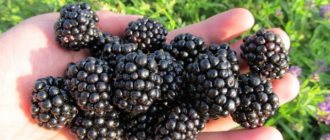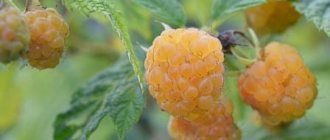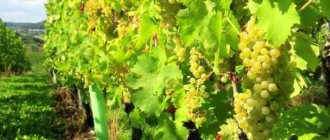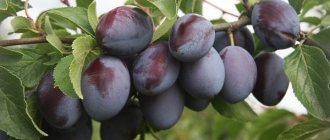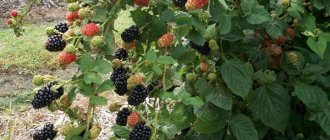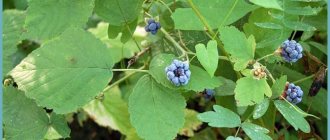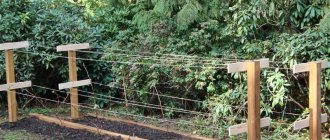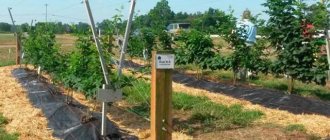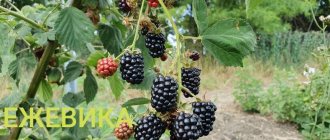Blackberry variety Natchez: description and characteristics, photos, reviews, planting and care, propagation and pruning
Just a few decades ago, blackberries were an exotic berry bush in Russia; gardeners practically did not grow them. But over time, the fruits of this shrub appeared for sale on the shelves of Russian stores, and some summer residents became interested in this crop.
As a result, an increasing number of gardeners are now planting this shrub in their gardens and believe that blackberries are not inferior in taste and composition to raspberries.
.
Many summer residents are trying to find the “ideal” variety of this berry bush, so they closely monitor the new varieties of blackberries that have been developed.
This article will talk about the thornless Natchez blackberry, its main characteristics, cultivation techniques and the main advantages of the variety.
The content of the article:
1. History of the variety 2. Description of the variety and characteristics 3. Productivity of the variety 4. Diseases and pests of blackberries 5. Advantages of the variety 6. Planting and cultivation 6.1 Planting dates in different regions 6.2 Selecting a site for planting 6.3 Rules for preparing planting holes 6.4 How to plant blackberries correctly 7. Further care 8. Feeding blackberry bushes 9. Pruning bushes 10. Propagation of blackberries 11. Reviews of Natchez blackberries
In which regions and cities can it be grown?
Each climate has its own characteristics. You need to familiarize yourself with them before planting the Natchez variety. The yield of a plant is also influenced by the location of planting, the level of light and shade, and the degree of wind blowability of the area.
The central territories of Russia, Ukraine, and Belarus are suitable for creating plantings of this blackberry variety. Local gardeners give preference not only to late varieties of berry bushes (for example, ozhin). They are attracted to the early flowering and harvest of the Natchez variety. A moderate climate will allow the bush to fully develop. The only negative is the presence of very cold winters and windy weather. In this case, planting will require careful shelter before the cold period.
Natchez blackberries are a heat-loving plant. That is why you should not create plantings of this variety in the cities of Siberia. Summer there is short and often rainy. This will not allow the bush to fully develop and bear fruit.
The berry bush can take root in the Urals. The main thing is to choose a favorable place for planting this variety of blackberry. A well-lit, windless area is suitable for her. Natchez's competitor in this region is the Ruben variety. Due to its resistance to frost. But it cannot boast of the same large and tasty berries.
The southern regions of Russia will be an ideal place for planting and propagating shrubs. Their climate is more suitable for the plant than others. The heat-loving bush will be saturated with sun throughout the entire flowering period. The berries will be much sweeter and juicier due to the duration of the warm period. The only nuance of the southern regions is the excessively high air temperature. This can lead to drying out of the soil. The plant will begin to hurt and stop bearing fruit. In such cases, it is necessary to organize frequent, thorough watering. It is worth moistening the soil 2-3 times a week. The shoots are sprayed with water. This will protect the blackberries from drought, keep their foliage green and the fruits bright and juicy.
Conditions for growing Natchez blackberries should be as comfortable as possible for the plant. A properly organized planting site will allow you to grow a healthy berry bush.
History of the variety
The year 1998 is considered to be the beginning of the breeding of the Natchez variety.
, when American breeders from the Arkansas Institute
crossed two varieties of blackberries - Ark.
1857 and Ark. 2005. The new bushes produced their first harvest only in 2001. At the same time, experts selected the most promising seedlings and carried out further tests for another 6 years.
As a result, in 2007, the new variety was patented and given the name Natchez (or Black Natchez, due to the almost black color of the berries).
Currently, American farmers are actively growing this variety on their plots, considering Natchez one of the best among all blackberry varieties today.
Photo of Natchez blackberry bushes
Morphological description of the variety
Characteristic:
- stems are semi-erect;
- height - 5 m;
- leaves are light green with fine jagged edges and a slightly hairy back side;
- flowers - simple, white, 5-6 petals;
- berries - black, slightly shiny;
- the shape of the berries is cylindrical;
- berry size - up to 5 cm in length;
- berry weight - up to 20 grams;
- flowering period - mid-May;
- ripening period - early variety, end of June.
In the first year, blackberries bear fruit with smaller berries - up to 3.5 cm and weighing up to 14 grams.
Natchez blackberries need staking, as the stems of this variety are very fragile and easily break under the weight of large berries.
Peculiarities:
- shoots - without thorns, very fragile, easily break off;
- berries - sweet with a slight sourness and a spicy hint of bitterness;
- drought resistance - tolerates drought well;
- yield - 15–20 kg per bush;
- winter hardiness - low, you need shelter for the winter;
- lighting - needs;
- fruits - can remain marketable for up to 14 days;
- blackberries - ripen for a long time, within 6-7 weeks;
- diseases - rarely affected by diseases and pests;
- 2nd development cycle - replacement shoots grow in the first year, and fruiting occurs in the second.
Ripe fruits may not fall off for a long time and remain in a ripe state
Blackberry Natchez: description of the variety and its characteristics
This blackberry variety is semi-creeping
, since its stems initially grow almost vertically (like those of the Ness blackberry or bramble), but subsequently they droop and practically creep along the surface of the ground. An adult shrub is strong and spreading, its vines can reach a length of up to 6-6.5 m. In the first season after planting, the stems of Natchez blackberries creeping along the ground grow up to 3.5-4.0 m.
The main difference of the Natchez variety is the complete absence of thorns on the shoots, which makes caring for the bushes and harvesting easier.
A Brief Overview of Natchez Blackberries - Video
In adult plants of this variety, shoots grow very quickly, lateral shoots with a large number of fruiting branches are formed. The foliage of this shrub is oval-ovate with sharp tips and small teeth along the edges. The surface of the leaf plates is terry, light emerald.
Need to know!
Natchez blackberry stems are not flexible, can break easily, and are prone to cracking.
GOOD BLUEBERRY VARIETY!
Blueberry Bluecrop
The roots of this blackberry variety are well developed, the more powerful they are, the more vegetative mass remains on the bushes after the pruning procedure during the formation of lashes.
The Natchez blackberry variety bears fruit only from last year's shoots.
The berries are cylindrical in shape, slightly elongated, rich black in color with a characteristic shine. The length of the fruit is about 4 cm, weighing up to 8.5-9 g. If this blackberry is provided with good care, and the distance between neighboring bushes is large enough, then some fruits grow up to 12.5 g.
Photo of Natchez blackberry sizes
Blackberry flowers are small, white, collected in racemose inflorescences, each of which can have up to 12-30 ovaries. Ripe fruits are of moderate density, moderately juicy, small drupes. The berries are firmly attached to the stalks, the detachment is dry.
On a note!
The taste of ripe fruits is sweetish with a slight hint of acid. Tasting assessment of the taste qualities of domestic Natchez - 4.3 points.
The quality of ripe berries is greatly influenced by the quality of care, the composition of the soil, as well as the climatic conditions of the growing region.
According to reviews from blackberry lovers, the berries of this variety have a slight coffee taste.
This variety is demanding on soil moisture, so you need to follow the watering regime. But the bushes tolerate heat well, but berries at temperatures above 38 degrees Celsius must be hidden from the sun's rays.
The frost resistance of the Natchez blackberry variety is not too high; the bushes can withstand cold temperatures down to -12-13 degrees Celsius.
Moreover, the shoots themselves practically do not freeze out during the winter, but the flower buds most often die. In the spring, the vegetative mass is quickly restored, but this berry bush will no longer have flowers or fruits this season. Therefore, even in the south of Russia, Natchez blackberries will have to be covered for the winter.
VARIETIES OF GOOSEBERRY!
Gooseberry Malachite Gooseberry Grushenka
The harvested crop tolerates transportation well at any distance
, has good keeping quality.
The Natchez variety is a dessert variety, so the berries taste sweet
. The fruits are consumed fresh and added to desserts. But jam or compote made from these blackberries alone turns out to be too sugary. Therefore, the best harvested harvest of this blackberry is suitable for making jam or assorted compotes.
Advantages and disadvantages
Despite the demands of blackberries on growing conditions, gardeners in reviews note more positive properties of the crop than disadvantages.
The benefits of Natchez blackberries include:
- early ripeness;
- versatility of purpose;
- dessert taste, large fruit size;
- extended fruiting up to 40 days;
- high genetically built-in immunity that protects the crop from pests and diseases;
- preservation of presentation and taste during long-term transportation;
- high productivity;
- absence of thorns, facilitating agrotechnical activities and berry picking;
Flaws:
- low frost resistance;
- need for support;
- insufficient replacement of shoots; additional planting material is required.
Blackberries are moisture-loving, demanding on the soil, varying degrees of illumination during the day.
Productivity of the Natchez blackberry variety
The ripening period of the Natchez berry bush is early.
The first flowers bloom in the second or third ten days of May. Fruiting lasts for several weeks - a total of about 40 days.
Natchez blackberry harvest - video
The ripening of Natchez blackberries in the southern regions begins in the second or third ten days of June, and in the middle zone - in the second ten days of July.
With good care, up to 20 kg of ripe berries are harvested from each adult plant of the Natchez variety.
CHOOSE VARIETIES OF BERRIES!
Strawberry Zephyr Raspberry Arbat Currant Dobrynya Cherry Lyubskaya
Harvesting and storage
In warm and sunny regions, blackberries begin to ripen by the end of June, in cooler regions - by mid-July. The moment of maturation can be determined by the following signs:
- the berry has turned black;
- the fruits have shine;
- 3–5 days have passed since the berries darkened;
- The sepals have become dry and the fruits are easy to pick.
Natchez blackberries are well transported over long distances, maintaining their excellent presentation. After collection, it can be stored for at least 10–14 days in the refrigerator without losing its properties and quality.
Advantages of the variety
The main advantages of the Natchez blackberry variety include:
- early fruit ripening;
- high productivity;
- large fruit;
- the harvested crop tolerates transportation well over long distances;
- ripe berries can be stored for quite a long time in appropriate conditions;
- a large number of shoots grow on the lashes in one season;
- the stems do not have thorns;
- high resistance of Natchez blackberries to diseases and pest attacks;
- dry fruit separation;
- fruiting is extended over 30-40 days;
- ripe fruits are well attached to the stalks and are not prone to shedding. Even overripe berries do not lose their taste, do not deteriorate, and their presentation remains unchanged;
- when the shoots freeze, you don’t have to worry about the crop – Natchez blackberries quickly recover.
But the variety also has a number of disadvantages:
- Natchez blackberries have low frost resistance;
- at high ambient temperatures, fruits can bake;
- shoots practically do not bend; they can break or crack when bent.
Characteristic
Reviews from gardeners about Natchez blackberries show its superiority over other cultivars. It would seem that this is the ideal dessert variety. But there's no need to rush. Only those who choose blackberries with maximum information will not be disappointed. Therefore, we advise you to read this chapter carefully.
Main advantages
Natchez is not a drought-tolerant variety. However, the entire culture is moisture-loving and requires regular watering. The bush tolerates heat well, but berries at temperatures higher than 35⁰ C require shading.
Winter hardiness of Natchez blackberries is also not the best. It tolerates frost no more than -14⁰ C. Moreover, the shoots withstand low temperatures quite well, but the flower buds freeze out. However, Natchez blackberries very quickly grow green mass and recover. But a frozen bush will not produce a harvest, so it will have to be covered even in the southern regions.
But the transportability of the berries of the Natchez variety is high, which is rare for blackberries with juicy fruits. There are no thorns on the shoots.
Growing Natchez blackberries requires some effort; they are not unpretentious. The choice of soil should also be approached responsibly - not only the quantity, but also the quality of the berries depends on this.
Flowering period and ripening time
The Natchez blackberry variety is one of the earliest. Depending on the region, it blooms from mid to late May. Fruiting is extended, lasting 35-40 days, sometimes longer. The beginning of berry ripening depends on the climate; in the south it is mid-to-late June. Natchez blackberries in the Moscow region ripen by mid-July.
Yield indicators, fruiting dates
The yield of Natchez blackberries is the highest among the dessert varieties of the Arkansas collection. From one adult bush you can collect 15-20 kg of berries. If we take into account the early fruiting and the absence of thorns, we can consider that the Natchez variety is close to ideal.
But not everything is as simple as enthusiasts would like. Replacement shoots in Natchez blackberries do not form well. Therefore, to obtain a high yield, it is grown in a two-year cycle. This means that during the fruiting season, all young shoots are cut out. In the spring of next year the bush will be “naked”, it will produce more new vines, but there will be no berries at all.
Area of application of berries
Natchez blackberries are a dessert variety - their berries are tasty and sweet. They are suitable for fresh consumption and making desserts. But the preparations made from it are “not very good” - here the sweet taste of the fruit plays a cruel joke, since jams and juices turn out “flat” and too sugary. But Natchez blackberries can be used for prefabricated compotes, multi-juices and assorted jams.
Resistance to diseases and pests
Like other blackberries, the Natchez variety is disease resistant and is rarely affected by pests. But preventive treatments need to be done, and you need to plant them away from nightshade crops, raspberries and strawberries. The ideal distance is at least 50 m; if possible, it should be maintained.
Advantages and disadvantages
Natchez blackberries have both advantages and disadvantages. However, the same applies to other varieties; the ideal does not yet exist.
The undeniable advantages include:
- Early ripening of berries.
- High yield.
- The berries are large, beautiful, with a high tasting score (4.6 points).
- The transportability and keeping quality of the fruit are very good.
- Natchez blackberry vines produce many side branches and fruiting branches.
- No thorns.
- The variety is resistant to diseases and pests.
- Dry picking of berries.
- Long-term fruiting.
- The berries are well attached to the stalk and do not fall off. If they are overripe, the taste and commercial quality do not deteriorate, so if necessary, you can delay harvesting. This is especially important for summer residents who come to the site once a week.
- If the bush is still frozen, you don’t have to be afraid of losing the variety - it has a high regenerative ability.
Disadvantages include:
- Low frost resistance of the variety.
- At temperatures above 35⁰ C, the fruits are baked.
- Natchez blackberry shoots do not bend well and can not only break, but also crack.
Natchez blackberries: planting and growing
Natchez seedlings are planted in the same way as other blackberry varieties.
When to Plant Natchez Blackberries - Planting Dates by Region
In the southern regions, it is recommended to plant this shrub in the autumn - approximately 25-30 days before the onset of frost.
In this case, the seedlings have time to take root before the beginning of winter.
Autumn planting of Natchez blackberries - video
In colder regions, Natchez blackberries are planted only in the spring.
when the soil warms up to a temperature of 15-17 degrees Celsius.
Selecting a site for planting the Natchez variety
The area for planting this berry bush should be well lit by sunlight and protected from gusts of cold wind.
In the southern regions, blackberry bushes should be shaded during hot weather.
Important!
The soil for this shrub should be slightly acidic, ideally loam, quite loose and fertile. Sandstone is not suitable for growing Natchez blackberries, since then the plant will have to be watered daily.
The groundwater level should not be closer to the ground surface than 1.4-1.6 m.
Rules for preparing planting holes for Natchez blackberries
It is very important to properly prepare planting holes for Natchez blackberries. This should be done in advance - a couple of weeks before planting Natchez blackberry seedlings. The diameter of the holes is about 0.5 m, and the depth is 0.55 m.
Planting Natchez blackberries in open ground - video
A nutrient substrate is also prepared in advance from garden soil, 10 kg of humus, 2.5 tbsp. l. potassium salts and 1.5 cups of superphosphate. Also, the soil should contain an increased amount of calcium. But calcium nitrate is usually not used before planting blackberries; it is better to add dolomite flour or crushed eggshells. Since Ca causes a decrease in soil acidity, high-moor peat should be added to the nutrient substrate at the same time.
Large amounts of organic fertilizers are added to sandy loam soils. If the soil is highly acidified, dolomite flour should be added to it.
How to Plant Natchez Blackberries
Natchez blackberry seedlings are usually purchased from nurseries or reputable stores. If seedlings with a closed root system are purchased, they should be watered before planting. And bare-rooted seedlings are placed in a bucket of water for 12 hours.
The distance between planting holes should be at least 3 m, since the bushes of this blackberry variety grow well.
Photo of blackberry planting
Planting holes are filled with nutrient substrate approximately 2/3 and filled with water completely.
Seedlings should be planted in holes prepared in this way after about 2 weeks.
A mound is made in the center of the hole, on which the seedling is placed, and the roots are spread along the sides of the hill.
A nutrient substrate is gradually poured on top, layer by layer, carefully compacting it.
The root collar is covered with 2 cm of soil. Then watering is carried out, and the trunk circle is mulched with a layer of peat.
Landing rules
The Natchez variety is planted in the same way as other blackberries. It’s just that it places increased demands on the soil, so simply digging a seedling into the area won’t work.
Recommended timing
In the south, blackberries are planted in the fall, but no later than a month before the expected frost, so that the young plant has time to take root. In regions with temperate and cool climates, excavation work is carried out in the spring, when the soil warms up. Then, before the onset of winter, the blackberries will have time to take root on the site.
Choosing a suitable location
Choose a place for Natchez blackberries that is sunny and protected from the wind. In the south, shading will be required in mid-summer. There should be no nightshade crops, raspberries and strawberries nearby.
The soil for blackberries is slightly acidic, preferably loose fertile loam. The Natchez variety should not be planted on sandy soil. Groundwater should not be located closer than 1-1.5 m from the surface.
Soil preparation
The Natchez variety needs pre-planting soil preparation more than other blackberries. The holes are dug at least 10-14 days in advance, with a depth and diameter of 50 cm. The nutrient mixture is prepared from the top layer of soil, a bucket of humus, 60 g of potassium, 120-150 g of superphosphate.
But the Natchez variety places increased demands on the calcium content in the soil. It is better not to add calcium nitrate when planting; dolomite flour or ordinary eggshells will do. But calcium reduces the acidity of the soil, so high-moor (red) peat should be included in the planting mixture.
If the soil is sandy, more organic matter is added to it. Excessive soil acidity is neutralized with dolomite flour (in this case it is preferable to lime). Sand is added to dense soil. The neutral or alkaline reaction of the soil is balanced by acidic (red) peat.
Selection and preparation of seedlings
Natchez blackberry seedlings should be purchased from trusted retail chains or directly from a nursery - the variety is relatively new, but there are many who want to purchase it. There is a high probability that they will sell you something that is not what you need.
Natchez blackberry shoots are thornless. They should be elastic, without cracks, stains or other damage. One of the signs of a healthy root system is the pleasant smell of fresh soil. Naturally, it should be well developed, without signs of fungi or rotting, the shoots should bend well and easily.
Before planting, blackberries purchased in containers are watered. The bare root is soaked in water overnight.
Algorithm and landing scheme
For Natchez, compact planting is not recommended. This blackberry forms a powerful bush with well-developed roots, thick shoots and many lateral branches. The best distance between plants is 2.7-3 m (in industrial plantings 2-2.5 m is allowed).
When compaction reaches 1-1.5 m, strict rationing of shoots and increased nutrition of blackberries will be necessary. But experienced gardeners claim that this leads to a decrease in yield per bush, so planting at a distance closer than 2 m between plants does not justify itself. In addition, the quality of berries with strong compaction drops significantly.
Landing sequence:
- A pit is prepared for blackberries, filled 2/3 with a nutrient mixture and completely filled with water. Let it sit for 10-14 days.
- A mound is formed in the center of the planting hole, around which the blackberry roots are spread.
- Cover the seedling with the nutrient mixture, constantly compacting it. The root collar should be buried 1.5-2 cm.
- Blackberries are watered abundantly, and the soil is mulched with humus or acidic peat.
Further care for Natchez blackberries
For the first few weeks, blackberries are watered regularly, preventing the top layer of soil from drying out.
The shoots of this blackberry should be tied to trellises, which should be three-row.
Adult plants are watered once every 7-8 days (if there is no rain), adding 40-50 liters of water under each bush.
During the period of active formation of ovaries and ripening of fruits, Natchez blackberries need to be watered twice a week, adding 2-3 buckets of water under each plant.
Rules for caring for blackberries for a large harvest
In the spring and autumn, the blackberry tree trunks should be loosened. And during the summer, a layer of mulch is added under the plants, which will help prevent rapid evaporation of moisture and prevent weeds from growing.
Blackberry agricultural technology
To grow brambles, you need a trellis up to 2.0-2.5 m high. Young shoots are fixed on a support as they grow, evenly distributed over a mesh or wire.
Watering
Blackberries grow well with moderate moisture: both a lack and an excess of water have an equally bad effect.
- in the absence of precipitation, it is necessary to water, but not more than once every 5-7 days, 3...4 buckets per bush.
- after flowering, during the period of fruit filling, the amount of watering is doubled - 30...40 liters. per bush is given 2 times a week.
Trimming
Fruiting and healthy growth of the bush depends on the formation and proper pruning. Pruning is carried out during the period of biological dormancy - late autumn or early spring before the buds begin to bloom.
- remove old, dry, thickening branches - leave 6...8 healthy stems for fruiting.
- the tops of the lateral branches of the 2nd order are shortened to 25...30 cm.
Maximum thinning of the bush increases illumination and promotes photosynthesis.
Top dressing
Natchez blackberries are fertilized at least 3-4 times per season. The variety is productive and large-fruited, therefore it requires enhanced agricultural technology, otherwise the fruits become smaller and lose their sugar content.
Feeding is carried out according to the following scheme:
- early spring: 1 bucket of rotted manure and a 1/2-liter jar of ash for each bush;
- at the beginning of the growing season, before flowering: fertilize with mullein or infusion of bird droppings, diluted with water in a ratio of 1:10.
- after harvesting the crop for digging - a 1/2-liter jar of ash and 150 g of superphosphate.
* Dosage is based on 1 plant.
Before the arrival of winter, the root zone is mulched with a layer of organic matter - compost or humus of at least 10 cm.
Preparing for winter
Natchez has low winter hardiness - up to minus 12...14 degrees below zero.
- The branches removed from the supports are subjected to sanitary pruning, tied into bunches and pressed to the ground.
- To fix the branches, pin them with wire or press them with a weight.
- depending on local weather conditions, they are covered for the winter with leaves, straw, sawdust or more reliable heat-protective material - film and agrofibre.
The best shelter from frost and dry winter wind is snow.
Protection from diseases and pests
Natchez is characterized by good resistance to most diseases and pests, however, preventive treatments are still indicated for the variety.
- The drug Oxychom in a concentration of 0.3-0.4% (less harmful and more modern analogue of Bordeaux mixture) in early spring against rust, anthracnose and septoria;
- Tobacco dust from mole crickets, aphids, caterpillars (infuse 100 g of tobacco dust in 5 liters of water for 3 days, strain, add another 5 liters of water and 3 g of liquid soap).
Feeding Natchez Blackberry Bushes
Since the bushes grow greatly during the summer and bear fruit abundantly, they need to be fed regularly during the summer. Otherwise, the fruits may simply not ripen to the end.
Spring feeding of blackberries - video
In the spring, Natchez blackberries need to be fertilized with fertilizers containing large amounts of nitrogen.
Experts recommend using calcium nitrate as such a fertilizer, which will simultaneously become a source of nitrogen and calcium.
During the period of budding and formation of ovaries, it is necessary to apply complex mineral fertilizers, which include, in addition to the basic elements, calcium.
Important!
When feeding blackberries, you should not use fertilizers that contain chlorine.
FERTILIZER!
Epin extra Fertilizer Azofoska Nitrogen fertilizer
Complex mineral fertilizing alternates with the addition of organic matter (mullein solution in a ratio of 1:10 or greenfinch in a ratio of 1:4). You can also feed the blackberries “leaf by leaf” a couple of times a season with a solution containing humates and chelates.
In the first ten days of September, a solution of potassium monophosphate must be added to this berry crop.
Vegetative propagation
Blackberries are propagated by shoot tips and root cuttings.
Shoots formed from buds on an underground rhizome
- For the first method, at the beginning of August and at the end of the summer, young shoots of this summer are buried in a vertical position in the ground, where they take root well during the fall.
- In the spring, the shoots are cut off and, using a sharp knife, cut out in a lump in the form of an overturned pyramid, they are transplanted in place of new rows.
- There is also a method that is used for overly growing varieties with standing victories, in which the root system is located more in a horizontal direction (this method is not applicable to creeping varieties, because their roots develop in a more vertical direction).
- Large, well-developed bushes are cut out of the ground with a sharp shovel and replanted in this form.
Blackberries are propagated by shoot tips and root cuttings.
Thus, in the place where the bush is removed, the ends of the roots remain, which in the same summer sprout and form several new independent plant specimens, suitable for replanting the following spring.
Natchez blackberries: bush pruning
This variety is grown as a biennial crop. This is due to the fact that Natchez blackberries produce a small number of replacement shoots. In the year of fruiting, all young shoots should be removed. Next season, quite a lot of them will form, but you need to leave only 7-8 of the strongest and healthiest.
Side shoots need to be shortened to 0.3 m. In this case, the bushes will not be overloaded with the harvest, and the berries themselves will be larger.
Blackberry pruning - video
After the entire crop has been harvested, old shoots should be cut out.
Sanitary pruning of Natchez blackberries is carried out throughout the summer, and all weak, dried out and damaged shoots should be removed.
Useful article:
How to improve the soil, its fertility, composition, structure
Reproduction methods
Natchez blackberries are most often propagated by vegetative methods.
Popular methods of crop propagation:
- Dividing the bush. An adult plant is dug up in early spring or autumn, the root is divided into several parts, each of which has two or three shoots. The delenki are immediately planted in the garden bed.
- Tops. Choose a one-year-old shoot at least one and a half meters long. The whip is bent to the ground, the top is buried in a previously prepared hole 20–30 cm deep, and watered. After 3–4 weeks, roots and green shoots form. The young shoot is separated from the mother plant next year.
- By layering. The method is identical to the previous one. The difference is that it is not the top that is buried, but the entire shoot and the depth of the groove is 5–10 cm.
- By cuttings. In the fall, 30–40 cm cuttings are prepared, which are buried in the ground until next spring. In April, segments of shoots are planted in a greenhouse at a distance of 10–15 cm from each other. After rooting and the formation of three leaves, seedlings 1 pc. grown in pots.
Blackberries are propagated by cuttings and by the dormant bud method. To do this, place a piece with two buds in a jar of water so that the liquid covers one bud. An independent seedling with a root system grows from it.
Natchez blackberry propagation
Natchez blackberries practically cannot be propagated by root cuttings.
.
They must be dug up in the autumn, placed in containers with sand during the winter and stored under certain conditions; such cuttings are planted only in the spring. Few replacement shoots and shoots of this blackberry are formed
.
Sprouting Natchez blackberries - video
Therefore, the only possible methods of propagating berry bushes remain
:
- Natchez blackberry propagation by layering;
- Pulping (the tops of the stems are cut off and rooted).
Propagation of Natchez blackberries by shoot tips - video
Both of these methods are very simple, so they are accessible even to novice gardeners.
The main thing is to carry out proper care - regularly water the branch branches.
Reproduction
For Natchez blackberries, the seed method of obtaining seedlings is not suitable - seeds obtained from the fruits of hybrid plants produce offspring with unpredictable indicators of yield and quality of berries.
To obtain planting material from a hybrid, only the vegetative method is suitable - only in this case the offspring exactly repeat the properties of the mother plant:
- rooting green cuttings;
- rooting the apical shoot using the “Chinese method”: pin the upper part of the shoot into the hole and sprinkle with earth, leaving the very tip on the surface. The sun's rays will activate the processes of regeneration and rooting
Maintaining a sufficient level of humidity allows you to count on the formation of roots within 1-2 months. Layers should be separated and planted in a permanent place in the spring, before sap flow begins.
Advantages and disadvantages
Natchez bush
As already mentioned, Natchez is loved by gardeners who grow blackberries on different scales. And this, accordingly, suggests that the variety has many positive qualities. Indeed, the advantages of such blackberries significantly exceed its disadvantages. The main advantages of the variety:
The quality of the fruits is excellent both in taste and in appearance. The safety of the berries, as well as their transportability, is at the highest level, which is important in industrial cultivation. Ripening occurs very early, compared to other blackberry varieties. Fruiting is very extended over time. Harvesting can take 5 weeks or even longer, and over time the number of berries only increases. The productivity of one bush is very high
This ensures high yields in small growing areas. The bushes are characterized by thornlessness. This quality makes it easy to grow and harvest Natchez blackberries. The plant is quite resistant to diseases and pests.
It is also important to know about the disadvantages of Natchez blackberries. Unfortunately, they also exist, like any other varieties of berries.
The most important disadvantage of the plant is considered to be poor winter hardiness. Temperatures below 14 below zero can cause significant damage to bushes. Therefore, they must be hidden for the winter under warm shelters. Sudden temperature changes are also detrimental to such blackberries. If the temperature drops sharply to -15-20, then the buds simply freeze, which has a bad effect on the yield of the next season.
Among the disadvantages of the variety is a high need for sunlight. Only when grown in bright areas with constant access to sunlight can you count on good yields. In the shade, Natchez blackberry bushes will also produce fruit. But the berries will become small and dry, the taste will be significantly lost - an unpleasant tartness will appear.
Experienced gardeners often talk about another drawback of this variety. We are talking about the excessive fragility of the branches. The shoots of the bushes are thinner than those of other varieties, while the berries are much larger and heavier. Shoots sometimes simply break off under the weight of the harvest. This is prevented by installing supports.
Propagation of thornless blackberries
Berry crops can be propagated in different ways. The seed method is rarely used, since it is not always possible to obtain the desired result. Most often they prefer propagation by vegetation. The optimal time for the procedure is considered to be autumn. Before winter, the roots of the plant will have time to get stronger, and in the spring they will produce young shoots.
Description of the best varieties of blackberries and features of choice for different regionsRead
Burying branches
The method involves obtaining a large number of young bushes. They take part of the horizontal apical layering and bend it to the ground without separating it from the mother bush. Then sprinkle the base with earth, leaving the top above the surface of the soil. To stop growth, shoots are pruned. To better secure the layering, it is pinned. The procedure is performed in early August.
Root shoots
The berry takes root best when propagated by root shoots. When the November cold sets in, the roots of the bush are slightly exposed and cuttings are cut from 6 to 9 centimeters long. Select those processes that are 1.5 centimeters thick. Store planting material in bags in the refrigerator or cellar. It is necessary to inspect the cuttings and ventilate them at least once a week. In February the shoots are placed in nutrient soil, and in April the grown shoots are placed in a permanent place in the garden.
Cuttings
Green cuttings are cut in autumn in October. Their length should not be less than 40 centimeters. All that remains is to dig them into the ground and leave them until spring. As soon as the snow melts, the lightly trimmed shoots are covered with film, creating a small greenhouse. They are regularly watered and the soil is loosened. The appearance of leaves is a signal for replanting to a permanent location.
Description of the variety, characteristics with photos
Large blackberries Natchez
Natchez is a very early blackberry. By the beginning of the second summer month, berries begin to ripen on the bushes. The harvesting process is quite lengthy. Blackberries ripen within 30-40 days, fruiting can last up to 5 weeks.
Plants have a semi-erect form. When the development of bushes just begins, most shoots grow vertically. Later they begin to droop and the bush becomes creeping. The length of the branches can reach 4-6 m. Fruiting young shoots are quite thick, with a large number of stepsons. The growth force is quite large.
The flowering period for Natchez blackberries is around mid to late May. The flowers have 5-6 petals and are white. The main value of the plant is its fruits. They are dark in color, cylindrical and elongated in shape. The density of the berries is moderate, they are quite heavy, but not harsh in taste. The weight of the berry can reach more than 12 g, but this is subject to all the rules of agricultural technology. On average, it reaches 7-10 g. The brushes consist of approximately 10-30 berries. Over time, their number increases. Flowering occurs in 2 waves, respectively, at the height of the season the yield increases significantly.
The appearance of the berry is one of its positive aspects, as is its taste. Shiny blackberries have a minimum of sourness, they are amazingly aromatic and sweet. The drupe is large, looks beautiful, the seeds are small, the berries are juicy with a refreshing taste.
The berries become ripe approximately 3-5 days after complete darkening. Ripe blackberries come off well and are transported perfectly.
Reviews from gardeners
Uralochka:
“The taste is sweet with a slight sourness, with a pronounced blackberry aroma. Mainly used fresh, but can be processed into jelly, jam, juice, wine. The most distinctive feature of the variety is high yield, large fruit size, good fruit quality, early ripening.”
Review on the “Grapes” forum
Marina-Ufa:
“The taste is excellent, there is no acidity, the drupes are small, there is a strong blackberry aroma. The berry is dense, transportable, but at the same time very juicy. The impression is extremely positive.”
Review on the “Grapes” forum
Conclusion: Natchez blackberries are prized for their lack of thorns, early ripening, and large berry size. But very brittle branches, low frost resistance and not the highest yield are the disadvantages of this variety.
Disadvantages of the variety
The Natchez blackberry variety is imperfect and has a number of disadvantages:
- The fruiting bush produces a small number of replacement shoots, which significantly limits the yield of the coming season. For this reason, a 2-year cycle is used, which consists of cutting out all formed new shoots in the second year, which gives the plant the opportunity to concentrate exclusively on fruiting;
- low winter hardiness: the vine is still able to withstand the cold, but the flower buds are sure to freeze. The maximum temperature that the plant can withstand is -14 ° C, so the factor of additional blackberry shelter is important. The bush is bent to the ground, mulched, and covered with dense agrofibre in several layers. In the northern regions, garden crops can be kept under arcs until warmer weather arrives, until the night frosts end.
Natchez blackberries, a description whose characteristics focus not on the insignificant disadvantages of the variety, but on its advantages (including its high resistance to disease), have won the respect and love of gardeners from different parts of the world.
Rules for choosing a suitable thornless blackberry variety
For those who want to grow fruit crops on their plot, they must consider whether the variety can withstand the climatic conditions of the region. After all, many of the plants can only ripen in warm climates. Spring frosts pose a danger to the crop, which can destroy the future harvest.
For the Moscow region
Regardless of the region's winter temperatures, it is best to cover blackberry bushes in the fall. Then we can say with confidence that the plant will bear fruit. Gardeners most choose those varieties that can withstand temperatures of 16-20 degrees below 0.
For central Russia
Gardeners in these areas are offered those crops that are well adapted to cool summers, winds and snowy winters. The thornless version of the berry bush is most suitable when it can be resistant to frost. Bushes with medium-length shoots are better suited. This is the Doyle variety, which grows well in the shade and tolerates light frosts. Of the repairers - Ruben. It is necessary to cover the berry plantation before the onset of cold weather.
For the Urals
Blackberries can grow in harsh conditions, but they choose crop types that can withstand both frost and cold winds. Flowers often die from return frosts in the spring. Therefore, frost-resistant plant species are preferable. This is together with Polar Agawam. You can use Black Satin or Waldo, but with shelter for the winter.
General description and characteristics
If for Russian summer residents the number of fruits collected from a bush and the labor intensity of agricultural technology play an important role, then Americans, spoiled by the variety of varieties, value the appearance, taste and aroma of Natchez blackberries.
Fruit
The weight of the berries in the shape of an elongated cylinder, as well as productivity, increases gradually. If in the second year after planting the blue-black fruits gain a mass of 10–14 g and grow up to 3 cm in length, then at the peak of fruiting the weight of the fruit increases to 20–25 g, the length reaches the size of a matchbox -5 cm.
Overripe Natchez blackberries differ from commercially ripe fruits by having a matte skin and loss of gloss.
The pulp of the berries is dense, there is no empty cavity like raspberries, and it is easily separated from the stalk. The taste of the fruit is sweet without sourness, with notes of coffee and a delicate aroma. The rating of professional tasters is 4.6 points.
Flowering and pollination
The long stalks of Natchez blackberries produce racemose inflorescences with numerous white, 5-petalled flowers. By mid-May, flowers bloom on the tops of the shoots. Then the middle buds bloom, and even later the lower ones.
But effective pollen transfer requires bees and a gentle wind. Nectar is especially attractive to bees at the beginning of flowering, so two days are enough to pollinate the crop.
Ripening dates and yield indicators
In the southern regions, Natchez blackberries ripen by mid-June, in the Moscow region - in early July. Fruiting lasts up to 1.5 months. The yield is high - up to 20 kg per bush. Abundant fruiting begins in the fourth year.
Area of application of berries
Natchez blackberries are consumed fresh, the fruits are used to make fresh juices, make jam, compotes, and add to baked goods.
The following properties of berries are used in folk medicine:
- astringent;
- diuretic:
- increased blood clotting;
- sedative.
Fresh blackberries saturate the body with a complex of essential vitamins and minerals and stimulate the immune system. When the juice is applied externally, festering wounds and old ulcers heal faster.
Blackberries improve intestinal peristalsis, secretory activity of the stomach, and alleviate painful conditions during colds.
Bush and leaves
The vines of the Natchez berry bush are semi-creeping. At the beginning of the growing season, the shoots of the plant are directed vertically upward, but having reached a height of 3 meters, they tend to the ground. In the first year of life, the vines reach a length of 4 m, in subsequent years they grow up to 6 m.
Sessile ovoid leaves grow simultaneously with shoots for a month. The light green leaf blades are pubescent, the edges are jagged, and the tip is pointed. At the junction of the leaf and the shoot, two buds are formed, from which new leaves and fruit branches grow the following year.
Root system
In addition to the main rhizome of the bush, adventitious shoots are formed, which can develop at a distant distance (up to 3 m) from the mother plant. The bulk of the root system is located in the upper layer of soil (15–40 cm), but individual roots go deep along the passages made by worms, up to 1.3 m.
Habitat
The heat-loving crop develops normally and bears fruit in the southern regions, in the temperate climate of Central Russia. Natchez blackberries do not take root in Siberia. During the short summer, the plant does not have time to form.
Frost and drought resistance
Most varieties of blackberries, and Natchez is no exception, are not winter-hardy crops. Frost is more - 15 ° C, sudden temperature changes are destructive for the kidneys. In winter, plant bushes require preparatory measures and insulation.
Blackberries do not tolerate drought well, stop developing, and lose part of the harvest.
Immunity to diseases and pests
Natchez blackberries received high immune protection from parental hybrids, which makes the crop less vulnerable to insect pests and diseases. Despite this fact, fruit and berry bushes are treated with special preparations for the purpose of prevention, and the rules for performing agrotechnical work are followed.
Advantages of the variety
Bred in 2007 (USA, University of Arkansas), the garden shrub is a close relative of the raspberry; it immediately appealed to many gardeners for the following qualities:
- wonderful, pronounced, refreshing, slightly sour taste of the fruit - large, about 4 cm in length. Sometimes the first berries have a pleasant, bitter coffee-like aftertaste;
- early ripeness. Natchez blackberries produce large black fruits while other varieties are still in the ripening stage;
- the absence of thorns is a factor conducive to acquiring such a thornless variety on your own plot;
- high transportability and preservation of the presentation of blackberries for a week.
The variety received its name in honor of the Natchez Indian people, who in ancient times lived in the valley of one of the greatest rivers in the United States - the Mississippi.
Some features of the variety
The Natchez blackberry, the variety description of which is of great interest to breeders, has powerful, erect, thornless shoots (about 4-6 meters long) growing in a vertical direction at the initial stage of growth.
Unlike related varieties, they can break under the influence of wind and the load of berries, so it is recommended to use support when growing. The most used option is three-wire; the height of the upper trellis is 1.7 meters. Otherwise, the stems take the position characteristic of creeping varieties. In September - early October, immediately after fruiting, the stems need to be removed from the trellis; It is at this moment that they are most pliable.
